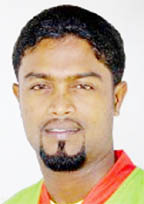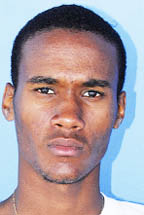THERE was one obvious reason for the disappointing climax to an otherwise heartening Digicel series for the West Indies at the Beausejours Stadium on Friday.
It was that Chris Gayle, Ramnaresh Sarwan and Shivnarine Chanderpaul contributed 36 runs between them and were all out with as many as 104 needed from 15 overs to overtake England’s 172 for five off their 29.
The stark reality is that, for all the spirit and commitment that have characterized the gradual rise from the depths over the past two years and were principally responsible for the hard-fought recapture of the Wisden Trophy, the West Indies remain far too heavily reliant on runs from those three.
The batting has been boosted by developments down the order but there are still gaping holes at No.2, as Gayle’s partner, and No.4, slotted in between Sarwan and Chanderpaul.
The team won’t be complete until they are adequately filled.
There has been just a solitary hundred in either position in the past 19 Tests – since Brian Lara’s retirement following the World Cup in 2007. It was at No.4 from the now suspended Marlon Samuels in South Africa almost a year and a half ago.

In that time, Gayle’s partners have been Daren Ganga, Devon Smith, Sewnarine Chattergoon and Xavier Marshall. Others, who for one reason or another have filled the position, are Dinesh Ramdin, Brenton Parchment, Dwayne Bravo and Lendl Simmons.
Ironically, 83 by Bravo, sent in against Sri Lanka last year when Gayle dropped himself down the order, and 86 by Marshall, chosen as No.4 but replacing the injured Chattergoon in the Barbados Test against Australia a few weeks later, are the best efforts.
Just when Samuels appeared, at last, to have begun to fulfill his clear potential in South Africa his naïve association with an alleged bookmaker drew him his two-year ban. Marshall and Ryan Hinds have filled the breach since without one score over 30 between them.
So where do the selectors look in their hunt for suitable candidates?
They won’t find anyone right away in the regional tournament where familiar names with chequered pasts led the season’s scorers before the current round – Narsingh Deonarine (950 runs), Floyd Reifer (902), Morton (851), Hinds (634), the Smiths, Dwayne (723) and Devon (359).
Dale Richards, aged 32, was picked as the newest opener for the first Test of this series but, through injury, is yet to have his chance. That may come next month in England but his is hardly a long term investment.
Chattergoon and Marshall have slipped completely off the radar as have Leon Johnson and Shaun Findlay, two young left-handers who were also on the trips to Toronto, Abu Dhabi and New Zealand last year.
The main hope for the future rests with a few young up and comers, none quite ready for promotion to the highest level. They first need proper preparation, roles for the long promised Academy and for the resumption to ‘A’ team tours.
The two likeliest are the Trinidadians, Adrian Barath, the little opener who will be 19 in 10 days time and is now in his third season, and Darren Bravo, just 20, the stylish left-hander who is Dwayne’s brother.
The Nevisian left-hander Kieran Powell 19 and Kraigg Braithwaite 16, the schoolboy opener from Barbados with 32 hundreds already to his name at various levels and 78 on his first-class debut on Friday, are among the others.

In the meantime, Gayle, Sarwan and Chanderpaul must continue to carry the upper order load, bolstered by the evidence that there is some stiffening down the list.
The return of Dwayne Bravo’s all-round quality and ebullience was an immediate boost in the limited-overs series, as it no doubt will when he is back for the Tests.
Brendan Nash, the dogged little left-hander from Jamaica by way of Australia, has brought much needed resilience to No.6 with important half-centuries (in each innings) against New Zealand in Napier in December and in the first Test against England in Kingston in February followed by his maiden hundred in the final Test in Port-of-Spain.
Wicket-keeper Dinesh Ramdin’s hundred, his first, at No.7 in the Bridgetown Test was belated proof of his previous underachievement with the bat. So was Jerome Taylor’s in Dunedin against New Zealand.
Coach John Dyson described each as a “significant breathrough”. Pertinently, all benefitted from the presence of one of the big three at the other end.
Nash had Chanderpaul twice and Gayle once in century partnerships that restored faltering innings while Ramdin’s 166 at Kensington was fashioned in a record seventh wicket stand as Sarwan accumulated his 291.
Throughout his 106 in Dunedin, Taylor’s partner was Chanderpaul.
As did their rare combined failures on Friday at Beausejours, such statistics accentuate just how crucial the top three are to the success of the team and how vital it is to find support around them in the upper order.
Either individually or together, they have figured in all three West Indies victories in the past 18 months – over South Africa, Sri Lanka and England. They have also been to the forefront of hard-fought draws.
Taylor’s five for 11 second innings burst routed England at Sabina that led to the stunning and, as it proved, decisive win in February but hundreds by Gayle and Sarwan initially earned a useful lead of 74.
The doggedness of the last pair, Fidel Edwards and Daren Powell, sealed the great escape at the Antigua Recreation Ground just over a week later but Sarwan’s 106 and his stand of 148 with Chanderpaul that occupied three and three-quarter hours on the last day set it up.
Last year, the same pair saw off the Australians’ press for victory at the ill-fated Sir Vivian Richards Stadium with second innings resistance for four and a half hours that yielded a partnership of 143, Sarwan with 128, Chanderpaul 70 to follow his 107 in the first innings, both with unbeaten stars against them.
The problem, as was clear in St. Lucia on Friday, is that they can’t do it every time. They need help.




